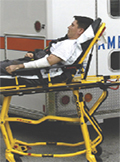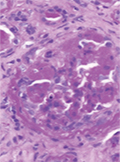The eLitMed.hu medical portal uses computer cookies for convenient operation. Detailed information can be found in the Cookie-policy.
LAM Extra for General Practicioners - 2014;6(05)
Content
[Parkinson’s disease from the perspective of general practice]
[Due to the recent developments in medicine, Parkinson’s disease became a relatively well-treatable condition. Recently the working abilities and the health-related quality of life of our patients dramatically improved by the application of optimal pharmacological and functional neurosurgical treatment options. Despite of these good progresses, the curative treatment option is still warranted. The aim of this review article is to present those pharmacological, neurosurgical and other treatments, which can improve the condition and quality of life of the patients. We also discuss the major concerns important for general practitioners including the assessment of driving abilities.]
[The prevalence of musculoskeletal symptoms among ambulance personnel in a national subsample]
[BACKGROUND - The ambulance workers face a lot of mental stress and physical demands in their everyday life. The physical demands can be originated from caring heavy equipment and moving patients. The poor mental health can strengthen physical problems, too. In this study our aim was to detect and compare the musculoskeletal status of ambulance personnel in two regions of Hungary. SAMPLE AND METHODS - On a voluntary base a cross-sectional anonymous, standardized self-fill-in questionnaire (Nordic Musculoskeletal Questionnaire) was used with additional items. All ambulance personnel over 18 years old were involved in the study who worked in direct patient care either in the North-Hungarian or in the West-Hungarian Region of the country. RESULTS - In the regional representative sample N=810 workers answered our questions. Out of them 587 persons (72.5%) reported about some musculoskeletal problem during his lifespan. Most of them suffered from lower back pain (448 persons, 55%), back pain (318 persons, 39%), neck pain (250 persons, 30.9%). Parallel with the aging and with the time spent working for the ambulance service more and more overall discomfort can be detected (p=0.013; p=0.020). Having a second job affected the level and frequency of discomfort negatively (p=0.005). CONCLUSIONS - More than 70% of the ambulance workers experienced musculoskeletal problem during his emergency workers carrier which may worsen the quality of his work and his personal life. To handle the situation primary prevention, screening and possibilities for recreation should be forced among ambulance workers. ]
[Health behaviour and cancer screening ]
[The purpose of the paper is to find out: what influences the participation in cancer screening. For answer, concepts such as health, health consciousness, health culture, health behaviour have been taken into account, and the factors that have an influence on the health behaviour considered. It concludes that the participation in screening makes a part of the health behaviour which is a mandatory task for the health education to include screening into the health message. ]
[Polyneuropathy as a first sign of microscopic polyangiitis]
[INTRODUCTION - Microscopic polyangiitis (MPA) is a systemic autoimmun disease characterized by necrotizing small vasculitis. MPA belongs to the ANCA-associated vasculitides. The disease can affect many of the body’s organ systems. Major organs involved are kidneys, skin, peripheral nerves and lungs. In addition, generalized symptoms such as fever and weight loss are very common. CASE REPORT - In January 2013 a 56-year old woman presented with weight loss, lower leg numbness, walking difficulty and petechiae on the lower legs. One month later, laboratory examinations showed progressive kidney dysfunction, anemia, hypersedimentation and elevated C reactive protein level, but further tests and investigations for potential bacterial infection and tumors were all negative. In sum, clinical signs and symptoms suggested systemic vasculitis, which was proved by the kidney biopsy and ENG examination. From these findings, microscopic polyangiitis was diagnosed with polyneuropathy and glomerulonephritis. The patient was a Hepatitis B (HBV) virus carrier, which can be provoking factor for vasculitis. Corticosteroid and six treatment cycles of intravenous pulse cyclophosphamide were performed for induction of remission. After treatment her symptoms improved and kidney function was normalized. Antiviral treatment was started because of HBV reactivation in October 2013. As a new manifestation of MPA, pulmonary symptoms were appeared in November 2013 and the patient was treated with synchronization of plasmapheresis and pulse cyclophosphamide with good clinical effectivity. Now, she is treated with methotrexate as immunosuppressive treatment and control examinations indicate the remission of the disease with proper renal function. CONCLUSION - We draw attention to a rare case of vasculitis and underline the importance of both the early diagnosis and the early and effective immunosuppressive therapy. Peripheral neuropathy may occur as a result of having systemic vasculitis. Nevertheless, the exploration and elimination of provoking factors are also must be part of the management and the regular follow-up is essential to recognize the disease relapses, thus avoid permanent organ damage.]
1.
Clinical Neuroscience
[Headache registry in Szeged: Experiences regarding to migraine patients]2.
Clinical Neuroscience
[The new target population of stroke awareness campaign: Kindergarten students ]3.
Clinical Neuroscience
Is there any difference in mortality rates of atrial fibrillation detected before or after ischemic stroke?4.
Clinical Neuroscience
Factors influencing the level of stigma in Parkinson’s disease in western Turkey5.
Clinical Neuroscience
[The effects of demographic and clinical factors on the severity of poststroke aphasia]1.
2.
3.
4.
5.






